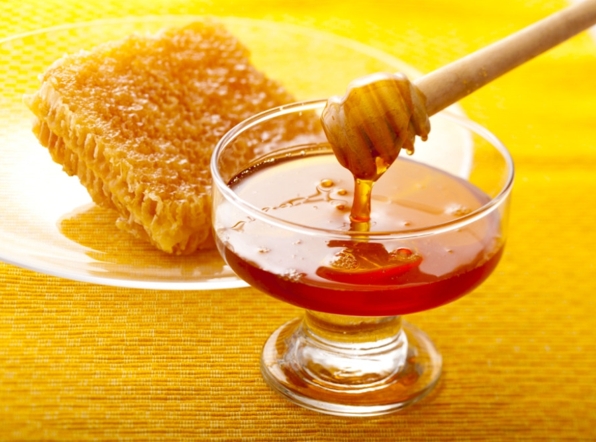Honey used to be a star on home sweetener rosters, along with maple syrup, as ‘natural, flavourful alternatives to table sugar. But lately it’s suffered an image hit. But honey prices have soared. And counterfeit honey is now a major problem…
 ‘Fruit of the Comb’: Real honey comes only from the waxen combs
‘Fruit of the Comb’: Real honey comes only from the waxen combs
of bee hives… Where the bees, in their tens of thousands, have
deposited nectar from nearby blossoms to age and thicken.
When I was little, we always had honey in the pantry. Back then, it was a relatively cheap, flavourful alternative to plain white sugar. It was great on ice cream, buttered roast and a natural partner for peanut butter. I think Mom used it in some special recipes interchangeably with corn syrup. We all loved it, and just assumed it would always be there on the breakfast table.
Times have changed
But times have changed – dramatically. Corn syrup’s status in the kitchen has fallen mightily, from ‘staple’ to an ‘incidental’. And honey is now one of the most-expensive sweeteners available – even pricier than maple syrup.
And honey lovers find themselves in an truly unenviable position.
As honey has soared in price, it has accordingly become a juicy target for adulteration and outright counterfeiting. There are many parallels with the huge, global criminal trade in counterfeit olive oil.
Many faces of fraud
Counterfeiters may dilute real honey with cheaper syrups. They may also add colouring to compensate for any lightening of the product. Another common dodge involves passing off cheap, lower-grade honey as premium stuff. Yet another subtle cheat is diluting real, premium honey with cheaper honey – much of which is imported from Asia and South America – as domestic.
And now some manufacturers – notably in China – are marketing entirely artificial honey. It looks, tastes and smells like honey, but lacks the healthy dimension and many of the valuable nutritional components of real honey.
What’s a honey lover to do?
The best most consumers can do to protect themselves against ‘honey fraud’ is to be aware of the cues they can use to spot fake honey at the store. Before they lay out their hard-earned, scarce cash.
Thanks to Camilla Jessen for the following rundown of points to ponder when choosing honey…
Foam Formation: Pure honey often has a layer of fine, foam-like bubbles at the top, resembling a sheepskin. If the jar lacks these bubbles, it might be an indicator of artificial honey.
Consistency: The texture of honey varies depending on its age. Fresh honey is typically fluid, while honey that has aged a few months may thicken and crystallize. This natural process is a good sign of pure honey.
Labeling: Recent regulations require clearer labeling of honey products. Always check the label for the country of origin and the apiary number where the honey was harvested. This information can help you trace the honey back to its source.
Additives: Be wary of honeys that contain added sugars or syrups. High-quality honey from reputable sources often doesn’t need any additives, as it’s naturally rich in flavor and nutrients.
Sensory Cues: While it’s difficult to test the scent of honey in a store, real honey typically exudes floral, woody, and resinous aromas, reminiscent of a beehive. If you’re familiar with these scents, they can serve as a guide to identifying authentic honey.
Price as a Quality Indicator: Real honey requires considerable effort to produce, which is often reflected in its price. If a honey product is surprisingly cheap, it may be a sign of lower quality or adulteration.
My take
I’ve tried to differentiate between honeys in my supermarket’s ‘spreads’ aisle using these pointers. And I have to say one of the most useful has been the evidence of fuzzy white foam on the surface of the product. You can usually see this stuff without removing the lid and breaking the safety seal.
Almost as compelling is the presence (or absence) of crystalized honey on the bottom of the jar. I vividly recall noting – even as s kid – the presence of crystalized product in virtually every jar of honey that came into our house. In fact, newspaper and women’s magazine articles appeared every year or so, explaining how to safely re-dissolve the ‘hardened’ honey by placing the whole jar in a warm water bath for half an hour or so.
But even if the honey you’re considering buying does pass these crucial tests, it may still be a lesser type labelled as premium. ‘Pure Clover’ may actually be pure honey, but made from the nectar of a less-desirable plant. Alas, this kind of fraud is almost impossible to detect without subjecting the product to lab tests.
~ Maggie J.

